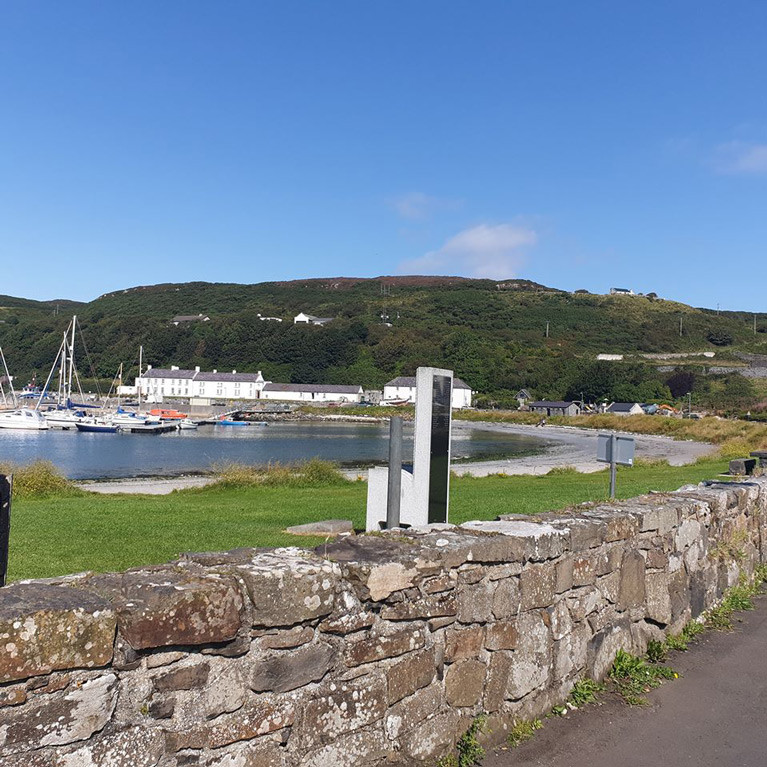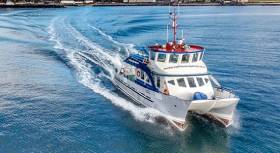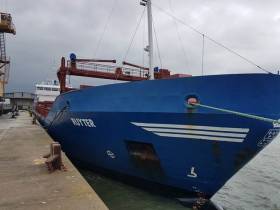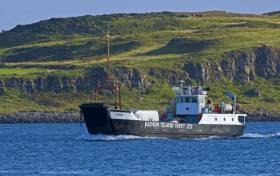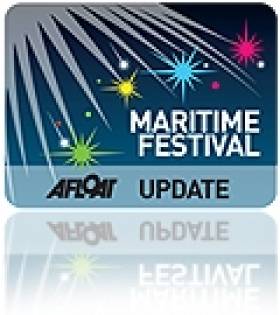Displaying items by tag: Rathlin Island
The Island of Rathlin in the Sea of Moyle off Ballycastle is now open to resident and visiting boat owners and overnighting is allowed. The ferry is also operating.
This popular destination is six miles long, one mile wide, "L" shaped and home to a slowly increasing population of around 140 people. Very strong tides surround the island. The pontoons in Church Bay will take up to 40 visiting boats. Water depth is good alongside but contact the Harbour Master directly for particular up to date hydrographical information.
Harbour Master John Moreton says that “ all visiting vessels must book in advance and will be asked to pre-pay, prior to arrival. This will secure a suitable berthing space and avoid disappointment. Anyone requiring fuel must also book in advance. Visitors are asked to adhere to current social distancing guidance and be aware of other users. Good hand hygiene will be essential, especially around common contact points such as handles and railings”.
A short walk from the harbour is the Boathouse Visitor Centre, where visitors can discover some of the exciting history, learn about present-day island life and see some artefacts from shipwrecks around the island. There are many enjoyable walks including along the shore to Mill Bay where you may see some of the resident seals basking or at play. Cycle hire is another way to enjoy the island or take a bus trip.
From April to July is puffin season so take the opportunity to see them along with many other sea birds.
The Harbour Master can be contacted for bookings at Rathlin on 07724594118 or at Ballycastle Marina on 028 207 68525/ 07803 505084
Five people were rescued off North Co Antrim yesterday afternoon (Friday 30 August) when their 33ft yacht got into difficulty near Rathlin Island.
Red Bay RNLI’s volunteer crew were requested to launch their all-weather lifeboat 1.20pm following a report that the yacht was struggling to make headway in difficult conditions at sea some five miles south-east of Rathlin.
Two of the crew onboard the yacht — which was on passage to Carrickfergus — were also suffering from seasickness, Red Bay RNLI says.
The lifeboat crew set up a tow and brought the vessel to Ballycastle. Speaking later, Red Bay RNLI press officer Paddy McLaughlin said: “Conditions at sea were challenging this afternoon and the crew made the right decision to call for help.”
Elsewhere, Clifden RNLI in Connemara launched its new all-weather lifeboat for the first time on Thursday afternoon (29 August) to reports of a RIB adrift and in danger in Ballinakill Bay between Letterfrack and Renvyle.
However, it was the D class inshore lifeboat Celia Mary which was first on the scene — where volunteers found two people on a 5.5m RIB with engine failure that was very close to the rocky shore in worsening weather conditions, with a Force 6 wind at the time.
Lifeboat helm Thomas Davis agreed with the two people on board the RIB that the vest course of action was a tow back to shore, which was safely completed.
Davis said: “We were glad to be able to help these people recover their boat today.
“We also wish to remind all water users in Connemara to contact the coastguard or emergency services at the earliest opportunity when things go wrong — we would always rather launch and be stood down than risk other possible outcomes.”
Ferry Rescues Divers Near Rathlin Island
A group of divers were rescued from their sinking boat by the Rathlin Island Ferry yesterday afternoon (Sunday 23 September).
Ferry skipper Michael Cecil told the Belfast Telegraph how he responded to the divers’ distress call while on his regular route from the Co Antrim island to Ballycastle on the mainland.
The divers were split between two boats separated by half a mile, one of which was filling quickly with water.
Cecil described “tricky” conditions trying to move his ferry alongside as even his own passengers lent a hand to the divers on board.
The Belfast Telegraph has more on the story HERE.
Captain Fined Over Negligence After Cargo Vessel Grounding
#Shipping - The captain of a cargo ship that ran aground on Rathlin Island last week has been fined £1,000 over his negligence at the helm, as the Belfast Telegraph reports.
The MV Ruyter, which was en route from Russia via Denmark and Scotland, sustained extensive damage to the front of its hull after running aground on the north side of Rathlin Island on the night of Tuesday 10 October.
However the damage was not noted till the vessel arrived at Warrenpoint in Carlingford Lough the following afternoon.
At a sitting of Armagh Court, Judge Paul Copeland found that Aleksandr Iakovotsov had broken international shipping codes over failure to keep a lookout to judge risk of collision, and a separate charge of failing to provide sufficient lookout “during the hours of darkness”.
The Belfast Telegraph has more on the story HERE.
#EntersService – The new custom-built car ferry Spirit of Rathlin has finally entered service with a first scheduled sailing today on the Rathlin Island link with Ballycastle on the Antrim mainland, writes Jehan Ashmore.
Spirit of Rathlin built by Arklow Marine Services at cost of £2.8m entered the route which caters for 6 vehicles and 140 passengers. The 28m long newbuild directly replaced the ageing Canna which performed a final crossing last night concluding two decades of loyal service.
The introduction of Spirit of Rathlin is based on a 10 year contract to Rathlin Ferry Co. This was awared to the ferry company following a tender process from Northern Ireland’s Department for Infrastructure (dfi) that funded the ferry.
Spirit of Rathlin is a boost to islanders and tourists alike as the new ferry offers better accommodation in the form of a saloon lounge area (seating 42) on the main deck. On the above decks 1 and 2, there is additional seating outside to take in the scenic views across Rathlin Sound.
In terms of freight he ‘Spirit’ will have the ability to convey an articulated truck and the newcomer will not be alone as the is also the passenger-only fastcraft Rathlin Express.
Prior to today’s opening, as previously reported on Afloat the new ferry had undergone further works at Mooney Boats, Killybegs. The work involved the use of the Donegal yard's syncro-lift.
In recent months, essential crew training was carried out before the Spirit of Rathlin was permitted a MCA certification. Also improvements to berthing infrastructure had to be completed in Ballycastle Harbour to accommodate the new ferry.
#Newbuild - A new customer for Mooney Boats of Killybegs, Spirit of Rathlin in which Afloat previously reported calling to the yard for work can now be further revealed, writes Jehan Ashmore.
The 6 vehicle / 140 passenger ferry Spirit of Rathlin according to Rathlin Ferry Ltd state they wish to announce a launch date very soon! The route is between Ballycastle on the mainland and Church Bay, and the £2.8m newbuild was constructed by Arklow Marine Services. In February vehicle loading trials of the ferry took place in Greystones Harbour.
The investment was funded by the Northern Ireland Department for Infrastucture (dfi) that awarded the contract to operate the vessel to Rathlin Ferry Co. Under the terms of the charter contract, the new ferry is to provide services to Northern Ireland’s only inhabited island for the next decade.
A delivery voyage by Spirit of Rathlin to the Antrim island had taken place in April, however the additional work required attending the Donegal yard. The type of work involved according to Mooney Boats is listed below:
Alterations to Front Ramp Hydraulics
Diesel gaskets replaced throughout vessel
Resealed coolers
Washed & Painted vessel
Supplied new glavanised anchor chain
Sandblasted and metalized anchors for vessel
When the 28m newbuild enters service, she is to directly replace the ageing Canna. At more than four decades old the ‘Island’ class car-ferry which is on charter, will be returned to Caledonian Maritime Assets Ltd (CMAL). They are responsible for the ship-management operations of Caledonian MacBrayne (CalMac) fleet that provide extensive services to the Scottish western isles and on Forth of Clyde.
Spirit of Rathlin will not be alone as the newcomer will partner passenger-only fastcraft Rathlin Express which will be a major enhancement of service for islanders and tourists alike. The vessel will have a saloon lounge area (seating 42) on the main deck. Further seating outside is available on decks 1 and 2 to take in the scenic views across Rathlin Sound. In addition the ‘Spirit’ will have the ability to convey an articulated truck.
However, the same number of vehicles will be transported likewise of Canna, though the carriage of cars on this service is restricted to island residents.
Rathlin is the only inhabited island off the Northern Ireland Coast and we think we are part of this island nation writes Tom MacSweeney. Our festival is about to happen celebrating all things Maritime and we would like as many people as possible to visit us and enjoy our maritime culture and heritage," says Mary O'Driscoll of the festival organising committee. "As well as markets and music, we will stage maritime have-a-go events - knots, ropes and nets making, and most importantly rowing the currachs and sailing the drontheims that were made during the festivals of the last 4 years. This is our 5th festival."
So, from the very heart of the spectacular Causeway Coast and Glens the communities of Ballycastle and Rathlin Island would like to extend a very warm welcome to celebrate their "rich and diverse maritime culture during the Rathlin Sound Maritime Festival" which runs from Friday, May 26, to Sunday, June 4.
The festival is centred on Rathlin Sound, the body of water that lies between Rathlin Island and Ballycastle. "From the adrenaline rush of the Sailing Regatta and races as well as exciting have-a-go activities, to tempting food and craft markets, seriously scenic guided walks, exciting and informative talks and tours, exhibitions and demonstrations, fun competitions, friendly giants, currach, Tall ship and Viking ships, there’s plenty to choose from including fantastic family friendly events.There’s a fun filled and packed programme of events at the 5th annual celebration of our rich maritime heritage," says Mary O'DrIscoll.
Rathlin Island Service Continues With 'Canna' While New Carferry Undergoes Crew Training
#Old&Newferry – Ferry services to Rathlin Island are operating though the new carferry Spirit of Rathin built in Arklow, remains undergoing essential crew training and certification from the Maritime Coastguard Agency, writes Jehan Ashmore.
The £2.8 newbuild car ferry built by Arklow Marine Service, is expected to enter service in a couple of weeks according to the Rathlin Ferry Co. The six-car vessel also capable of handling an articulated truck and 140 passengers, will use the new £1 million berthing facility spent on improving Ballycastle Harbour. Introduction of the newbuild will improve the standards of service for the island’s population of 110 and visitors boosting the local economy.
Current operations are been maintained by car ferry Canna and a relief 'passenger-only' ferry on Ballycastle-Rathlin Island (Church Bay) route. This passenger-only ferry has replaced the larger Rathlin Express while away in dry-dock. Afloat has identified that this larger fastferry is undergoing works at Mooney Boats in Killybegs.
Spirit of Rathlin will replace Canna, a Caledonian Maritime Assets Ltd’s (CMAL). The car ferry since 1997 has served on the Sea of Moyle that separates the mainland and the island.
The ‘Island’ class car ferry named after the Scottish island was built in 1976. Originally the five-car ferry began service for Caledonian MacBrayne (CalMac) on the Western Isles routes.
#FerriesInArt – A beautiful art work depicting the current pair of Rathlin Island serving ferries will be a lovely keepsake for the operator as one of the vessels is soon to be replaced by a newbuild, writes Jehan Ashmore.
The colour sketched drawing show the ferries underway off Fair Head on the stunning Antrim coast and also on Rathlin. They are operated by Rathlin Island Ferry Ltd. On the left is the passenger-only fast-craft Rathlin Express and the vehicle-loading Canna which is to be sold as new car-ferry is to take over this Spring.
Canna, a veteran vessel dating to 1976 will be replaced by Arklow Marine Services built Spirit of Rathlin which notably made a hisitoric call to Greystones Harbour, Co. Wicklow. The call last month was to enable the 28m long newbuild carry out berthing-vehicle loading trials at a slipway that involved a car and a van. The east coast harbour was built in recent years to include a marina that replaced a much smaller harbour that was restricted to boats only using moorings.
On a related note, Spirit of Rathlin will use newly upgraded facilities in Ballycastle Harbour from where the service is operated on behalf of the Northern Ireland Government. The Department for Infrastructure commissioned the new ferry and in which the Dfi have on charter tendered to Rathlin Island Ferry Ltd.
Afloat adds that the Spirit of Rathlin will notably be the first custom built car ferry to serve Rathlin Island. Visitors however are not permitted to bring their vehicles onto the only inhabited island off Northern Ireland which has population of around 150 and is increasing. The passage times across the Sea of Moyle take 45 minutes by Canna while those undertaken by Rathlin Express are not surprisingly less by taking just 25 minutes.
The Spirit of Rathlin will have the same capacity of the Canna, which can handle six vehicles and 140 passengers, however the newbuild has slightly overall larger dimensions. In addition to a more spacious lounge for passengers housed in a bigger superstructure, likewise of Canna is located at the stern.
The origins of Canna given its namesake are a clue, as the ‘Island’ class was one of several commissioned for the Scottish Government state funded ferry operator Caledonian MacBrayne (CalMac). They extensively serve the Inner and Outer Hebrides that form the Western Isles.
Incidentally, Canna when first introduced on the Rathlin Island service which was operated by CalMac. In 2008 Cork businessman Ciaran O’Driscoll took over the ferry service having already established one serving Cape Clear Island. A unique position to be in by operating to Ireland’s most southerly island while also to Rathlin, its most northerly.
The Cape Clear Island Ferry service links Baltimore as well Schull using a trio of passenger-only ferries.
Friday 10th May saw the launch of the Rathlin Sound Maritime Festival, set to be one of the highlight events of the summer, beginning later this month on 24 May. The launch event was held at Portnagree House Harbour & Marina Visitor Centre in Ballycastle, the building that is home to the Harbour Master's office and the Visitor Information Centre and offers impressive facilities for both visitors and locals. The launch event was organised and hosted by Caroline Carey, Acting Tourism Development Manager for Moyle District Council and John Morton, Harbour Master for Moyle District Council, both part of the Festival steering group.
Moyle District Council Chairman Cllr Sandra Hunter welcomed everyone to the launch event and paid tribute to the work of the Festival steering group and all the organisations involved for their efforts to put together such an exciting programme of activities throughout the Festival dates of 24 May to 02 June 2013. The Festival has been organised by a team comprising Moyle District Council tourism and marina staff, Rathlin Development and Community Association, Ballycastle Community Development Group and Ballycastle Chamber of Commerce. Michael Cecil, Chair of Rathlin Development and Community Association, Paul Kerrigan Chair of the Ballycastle Community Development Group and Mary O'Driscoll, Chair of Ballycastle Chamber of Commerce all spoke at the launch to welcome the guests and acknowledge the strong working relationships between the Festival team and outside organisations which has demonstrated how the local area and local businesses can be successfully promoted through this and other exciting tourism events in the Moyle area. A host of other organisations from across NI and beyond are also involved and will be running activities during the Festival, including Ulster Wildlife Trust, NI Environment Agency, Bushmills Distillery, NI Libraries, National Trust Giant's Causeway Visitor Centre, Ballycastle Market and many more with representatives present at the launch event.
Guests were treated to samples of the excellent local produce available in Moyle with catering by local cafe Thyme & Co and Morton's Fish Shop, provided courtesy of Malin Waters and their Sail West programme, with the focus on seafood to tie in with the overall maritime theme of the Festival.
Heavy showers didn't dampen enthusiasm at the event with guests also visiting Ballycastle marina to see the iconic Colmcille currach, currently moored in Ballycastle and soon to head to Iona in the Western Isles of Scotland before making the return journey to Rathlin Island to take part in the Festival later this month.
The full programme of activities has recently been released for the first Rathlin Sound Maritime Festival which will run from Friday 24th May to 2nd June 2013. Programs with full activity listings as well as tickets for the music events are now available from Ballycastle Visitor Information Centre at Portnagree House on Bayview Road. Headline acts include among others Bap Kennedy, Bagatelle and Skerryvore.
The Rathlin Sound Maritime Festival is aimed at celebrating and promoting local maritime heritage, history, culture, music and food and has grown out of a number of conversations within local communities as well as last year's successful Sailing Regatta. There has also been great interest from various organisations throughout Northern Ireland and beyond to participate.
This festival is centred on Rathlin Sound, the body of water that lies between Rathlin and Ballycastle and is about inspiring a passion for the sea by bringing together a rich mix of activities and events both on the sea and on land with an overall maritime theme. Events will focus on Ballycastle for the opening weekend and Rathlin for the closing weekend with plenty of activities in both locations throughout the Festival dates.
With on the water and seaside based 'get involved' activities including kayaking, diving, paddleboarding, surfing and more, historic and modern sea craft, dinghy and yacht racing, competitions, local and historic talks, tours, guided walks, open days and exhibitions there will be something to interest everyone including plenty of family friendly activities. The Festival will also include a special seafood themed food and craft market with cookery demonstrations, and a Can't Cook Won't Cook challenge by local Councillors. Local cafes, bars and restaurants will also be offering special menus and events throughout the event to celebrate our unique food offering. In the evenings there will be a wealth of entertainment to choose from including music, drama and films including great local, national and international singers and bands.
Full details of all activities and events can be found in the Festival program available at Ballycastle Visitor Information Centre and online on Moyle's new tourism website at www.heartofthecausewaycoastandglens.com >, and also on facebook at www.facebook/HeartofCCAG or the festivals dedicated page as well as on twitter @heartofccag Head to Ballycastle and Rathlin Island at the heart of the Causeway Coast and Glens this bank holiday weekend 24 May to 02 June for a fantastic family friendly event listed as one of the top events for this year in the NITB International Visitor Guide, on The Gathering website and in Belfast Telegraph's Ultimate Events Guide for NI.



























